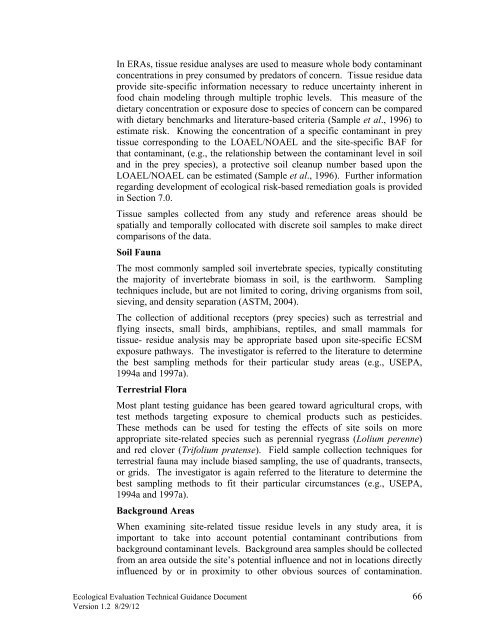Ecological Evaluation Technical Guidance - State of New Jersey
Ecological Evaluation Technical Guidance - State of New Jersey
Ecological Evaluation Technical Guidance - State of New Jersey
- No tags were found...
Create successful ePaper yourself
Turn your PDF publications into a flip-book with our unique Google optimized e-Paper software.
In ERAs, tissue residue analyses are used to measure whole body contaminantconcentrations in prey consumed by predators <strong>of</strong> concern. Tissue residue dataprovide site-specific information necessary to reduce uncertainty inherent infood chain modeling through multiple trophic levels. This measure <strong>of</strong> thedietary concentration or exposure dose to species <strong>of</strong> concern can be comparedwith dietary benchmarks and literature-based criteria (Sample et al., 1996) toestimate risk. Knowing the concentration <strong>of</strong> a specific contaminant in preytissue corresponding to the LOAEL/NOAEL and the site-specific BAF forthat contaminant, (e.g., the relationship between the contaminant level in soiland in the prey species), a protective soil cleanup number based upon theLOAEL/NOAEL can be estimated (Sample et al., 1996). Further informationregarding development <strong>of</strong> ecological risk-based remediation goals is providedin Section 7.0.Tissue samples collected from any study and reference areas should bespatially and temporally collocated with discrete soil samples to make directcomparisons <strong>of</strong> the data.Soil FaunaThe most commonly sampled soil invertebrate species, typically constitutingthe majority <strong>of</strong> invertebrate biomass in soil, is the earthworm. Samplingtechniques include, but are not limited to coring, driving organisms from soil,sieving, and density separation (ASTM, 2004).The collection <strong>of</strong> additional receptors (prey species) such as terrestrial andflying insects, small birds, amphibians, reptiles, and small mammals fortissue- residue analysis may be appropriate based upon site-specific ECSMexposure pathways. The investigator is referred to the literature to determinethe best sampling methods for their particular study areas (e.g., USEPA,1994a and 1997a).Terrestrial FloraMost plant testing guidance has been geared toward agricultural crops, withtest methods targeting exposure to chemical products such as pesticides.These methods can be used for testing the effects <strong>of</strong> site soils on moreappropriate site-related species such as perennial ryegrass (Lolium perenne)and red clover (Trifolium pratense). Field sample collection techniques forterrestrial fauna may include biased sampling, the use <strong>of</strong> quadrants, transects,or grids. The investigator is again referred to the literature to determine thebest sampling methods to fit their particular circumstances (e.g., USEPA,1994a and 1997a).Background AreasWhen examining site-related tissue residue levels in any study area, it isimportant to take into account potential contaminant contributions frombackground contaminant levels. Background area samples should be collectedfrom an area outside the site’s potential influence and not in locations directlyinfluenced by or in proximity to other obvious sources <strong>of</strong> contamination.<strong>Ecological</strong> <strong>Evaluation</strong> <strong>Technical</strong> <strong>Guidance</strong> Document 66Version 1.2 8/29/12
















